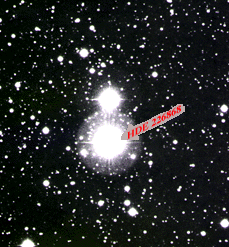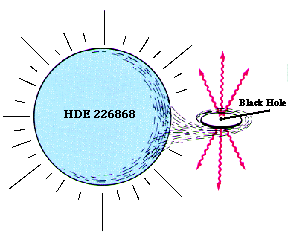BLACK HOLES
http://imagine.gsfc.nasa.gov/docs/science/know_l2/black_holes.html
The Schwarzschild radius can be calculated using the equation for escape speed:
vesc = (2GM/R)1/2 For photons, or objects with no mass, we can substitute c (the speed of light) for Vescand find the Schwarzschild radius, R, to be
R = 2GM/c2 If the Sun was replaced with a black hole that had the same mass as the Sun, the Schwarzschild radius would be 3 km (compared to the Sun's radius of nearly 700,000 km). Hence the Earth would have to get very close to get sucked into a black hole at the center of our Solar System.
However, if a black hole passes through a cloud of interstellar matter, or is close to another "normal" star, the black hole can accrete matter into itself. As the matter falls or is pulled towards the black hole, it gains kinetic energy, heats up and is squeezed by tidal forces. The heating ionizes the atoms, and when the atoms reach a few millionKelvin, they emit X-rays. The X-rays are sent off into space before the matter crosses the Schwarzschild radius and crashes into the singularity. Thus we can see this X-ray emission.

The optical companion of
the black hole candidate Cygnus X-1Binary X-ray sources are also places to find strong black hole candidates. A companion star is a perfect source of infalling material for a black hole. A binary system also allows the calculation of the black hole candidate's mass. Once the mass is found, it can be determined if the candidate is a neutron star or a black hole, since neutron stars always have masses of about 1.5 times the mass of the Sun. Another sign of the presence of a black hole is its random variation of emitted X-rays. The infalling matter that emits X-rays does not fall into the black hole at a steady rate, but rather more sporadically, which causes an observable variation in X-ray intensity. Additionally, if the X-ray source is in a binary system, and we see it from certain angles, the X-rays will be periodically cut off as the source is eclipsed by the companion star. When looking for black hole candidates, all these things are taken into account. Many X-ray satelliteshave scanned the skies for X-ray sources that might be black hole candidates.
Cygnus X-1 (Cyg X-1) is the longest known of the black hole candidates. It is a highly variable and irregular source, with X-ray emission that flickers in hundredths of a second. An object cannot flicker faster than the time required for light to travel across the object. In a hundredth of a second, light travels 3,000 kilometers. This is one fourth of Earth's diameter. So the region emitting the X-rays around Cyg X-1 is rather small. Its companion star, HDE 226868 is a B0 supergiant with a surface temperature of about 31,000 K. Spectroscopic observations show that the spectral lines of HDE 226868 oscillate with a period of 5.6 days. From the mass-luminosity relation, the mass of this supergiant is calculated as 30 times the mass of the Sun. Cyg X-1 must have a mass of about 7 solar masses, or it would not exert enough gravitational pull to cause the wobble in the spectral lines of HDE 226868. Other estimate put the mass of Cyg X-1 to as much as 16 solar masses. Since 7 solar masses is too large to be a white dwarf or neutron star, it must be a black hole.
Black Holes
NOTE: This section is about stellar-mass black holes. For information about black holes that measure in the billions of solar masses, see Active Galaxies & Quasars . There are many popular myths concerning black holes, many of them perpetuated by Hollywood. Television and movies have portrayed them as time-traveling tunnels to another dimension, cosmic vacuum cleaners sucking up everything in sight, and so on. It can be said that black holes are really just the evolutionary end point of massivestars. But somehow, this simple explanation makes them no less mysterious, and no easier to understand.Black holes: What are they?
Black holes are the evolutionary endpoints of stars at least 10 to 15 times as massive as the Sun. If a star that massive or larger undergoes a supernova explosion, it may leave behind a fairly massive burned-out stellar remnant. With no outward forces to oppose gravitational forces, the remnant will collapse in on itself. The star eventually collapses to the point of zero volume and infinite density, creating what is known as a "singularity." Around the singularity is a region where the force of gravity is so strong that not even light can escape. Thus, no information can reach us from this region. It is therefore called a black hole, and its surface is called the "event horizon." But contrary to popular myth, a black hole is not a cosmic vacuum cleaner. If our Sun was suddenly replaced with a black hole of the same mass, Earth's orbit around the Sun would be unchanged. Of course, Earth's temperature would change, and there would be no solar wind or solar magnetic storms affecting us. To be "sucked" into a black hole, one has to cross inside the Schwarzschild radius. At this radius, the escape speed is equal to the speed of light, and once light passes through, even it cannot escape.The Schwarzschild radius can be calculated using the equation for escape speed:
If we can't see them, how do we know they are there?
Since stellar black holes are small (only a few to a few tens of kilometers in diameter), and light that would allow us to see them cannot escape, a black hole floating alone in space would be hard, if not impossible, to see in the visual spectrum.However, if a black hole passes through a cloud of interstellar matter, or is close to another "normal" star, the black hole can accrete matter into itself. As the matter falls or is pulled towards the black hole, it gains kinetic energy, heats up and is squeezed by tidal forces. The heating ionizes the atoms, and when the atoms reach a few millionKelvin, they emit X-rays. The X-rays are sent off into space before the matter crosses the Schwarzschild radius and crashes into the singularity. Thus we can see this X-ray emission.

The optical companion of
the black hole candidate Cygnus X-1
Cygnus X-1 (Cyg X-1) is the longest known of the black hole candidates. It is a highly variable and irregular source, with X-ray emission that flickers in hundredths of a second. An object cannot flicker faster than the time required for light to travel across the object. In a hundredth of a second, light travels 3,000 kilometers. This is one fourth of Earth's diameter. So the region emitting the X-rays around Cyg X-1 is rather small. Its companion star, HDE 226868 is a B0 supergiant with a surface temperature of about 31,000 K. Spectroscopic observations show that the spectral lines of HDE 226868 oscillate with a period of 5.6 days. From the mass-luminosity relation, the mass of this supergiant is calculated as 30 times the mass of the Sun. Cyg X-1 must have a mass of about 7 solar masses, or it would not exert enough gravitational pull to cause the wobble in the spectral lines of HDE 226868. Other estimate put the mass of Cyg X-1 to as much as 16 solar masses. Since 7 solar masses is too large to be a white dwarf or neutron star, it must be a black hole.
 |
| An illustration of Cygnus X-1, showing the companion star HDE 226868, the black hole, material streaming from the companion to the black hole, and the emission of X-rays near the black hole. |

Tidak ada komentar:
Posting Komentar